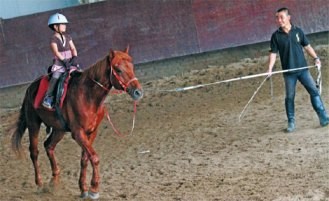Equestrian or horse riding is becoming a popular pastime for many Chinese children in the past five years, the China Daily reported.
Wu Zhala, editor-in-chief of Chinese equestrian website Horse.org.cn, said that most new riders are children who were brought to equestrian clubs by their own parents to learn horse riding.
"Parents hope their children can get fit and learn to respect animals and nature," Wu said.
According to Wu, Beijing's 150 equestrian clubs have an average of 100 members younger than 18.
Zhang Xiao-xue, a senior riding coach with Huanglin Horsemanship in the Daxing District of Beijing, said that the sport has new popularity as pastime in the past five years. His ranch now has about 200 members who must make their reservations before visits.
The report said that most stables generally charge 150-500 yuan ($24-80) per lesson for packages of 30-50 sessions.
Ma Limei, a parent, brought her 8-year-old son to a ranch in a northeastern Beijing suburb to learn how to ride.
"I sent him to learn horsemanship to exercise his body and cultivate his temperament," Ma said. "There's a charm to horsemanship that especially appeals to kids that may provide a sense of fulfillment."
Ma said that she spent more than 10,000 yuan on 70 45-minute classes, but the fee does not include tutorship, which costs an additional 200 yuan per session.
As her son learned to ride by himself after two months of training, Ma believed it was money well spent.
Stables accept children to start at age 5 and give 10-20 lessons before they can mount and ride independently by themselves.
According to the International Equestrian Federation, teens should master the basics before they are allowed to tackle hurdle races and dressage, in which the horse and rider "perform from memory a series of predetermined movements." The federation said that dressage is "the highest expression of horse training."
Although Chinese literature depicts riding as a literally unbridled adventure, present-day equestrians observe a "safety-first" motto.
Liu Jianhe, a senior Huanglin member, said that injuries are often caused by improperly trained horses and riders. He said that based on British-style horsemanship, the first step is to teach children about horses and their habits, and allowing children to interact with the animals.
"Children should understand horses are timid," Zhang said. He reminded riders not stand behind horses, as standing in their blind spot may probably cause the horses to kick.
They also need to learn to feed them with open palms to prevent biting, Zhang added.
Zhang believes riding can enhance the communication skills of children and riding can improve one's posture.
"They'll have to not only connect with coaches but also use body language to express themselves to the horses," Zhang said.



























